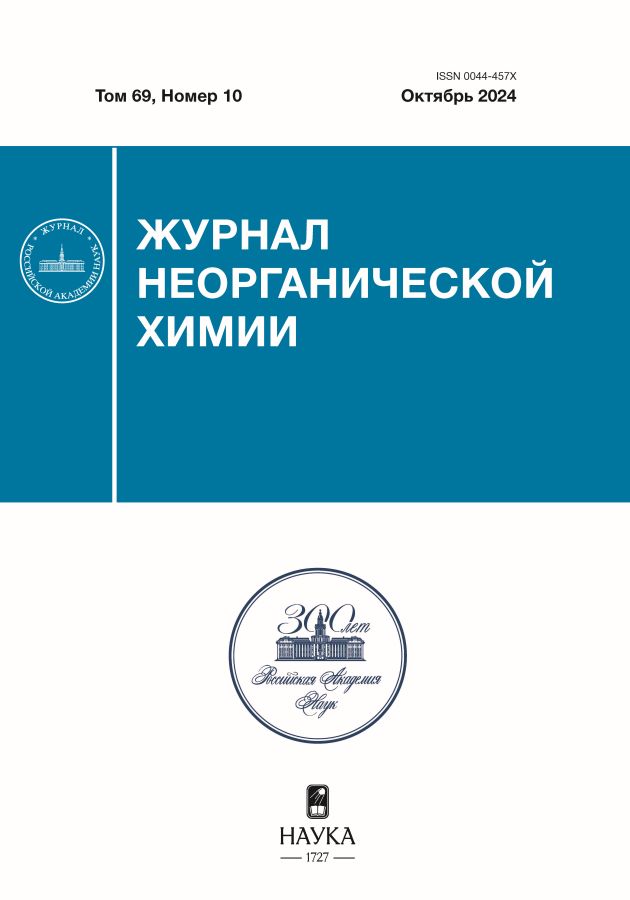On Polymer Complexes of Gold(I) with Glutathione in Aqueous Solution
- Авторлар: Mironov I.V.1, Kharlamova V.Y.1
-
Мекемелер:
- Nikolaev Institute of Inorganic Chemistry of the Siberian Branch of the Russian Academy of Sciences
- Шығарылым: Том 69, № 10 (2024)
- Беттер: 1449-1458
- Бөлім: ФИЗИКОХИМИЯ РАСТВОРОВ
- URL: https://rjraap.com/0044-457X/article/view/676635
- DOI: https://doi.org/10.31857/S0044457X24100117
- EDN: https://elibrary.ru/JIBKNW
- ID: 676635
Дәйексөз келтіру
Аннотация
Processes involving gold(I) glutathionate complexes in aqueous solution at t = 25°C and I = 0.2 M (NaCl) in the pH range 7.20–6.06 (CAu = (5–10 × 10–4 M)) were studied. Using mass spectrometry, it was shown that at CGS > CAu, in addition to monomeric Au(GS)2*, there can exist polymeric forms Au4(GS)4*, as well as Aun(GS)n+1*, where n ≤ 4, the symbol * means the sum of forms of different degrees of protonation. From UV spectroscopy it follows that in the entire region of 0.5 < CGS/CAu < 3, spectra of four forms, including Au(GS)2*, are sufficient to describe all spectra within experimental errors in the form of a linear combination. As pH decreases, the proportion of Au(GS)2* decreases. The equilibrium constant 0.25 Au4(GSH)44– + GSH2– = Au(GSH)23– + H+ is equal to lgK = –4.4 ± 0.1 (I = 0.2 M, NaCl).
Негізгі сөздер
Толық мәтін
Авторлар туралы
I. Mironov
Nikolaev Institute of Inorganic Chemistry of the Siberian Branch of the Russian Academy of Sciences
Хат алмасуға жауапты Автор.
Email: imir@niic.nsc.ru
Ресей, Novosibirsk, 630090
V. Kharlamova
Nikolaev Institute of Inorganic Chemistry of the Siberian Branch of the Russian Academy of Sciences
Email: imir@niic.nsc.ru
Ресей, Novosibirsk, 630090
Әдебиет тізімі
- Shaw III C.F. // Chem. Rev. 1999. V. 99. P. 2589. https://doi.org/10.1021/cr980431o
- Singh N., Sharma R., Bharti R. // Mater. Today: Proc. 2023. V. 81. P. 876. https://doi.org/10.1016/j.matpr.2021.04.270
- Darabi F., Marzo T., Massai L. et al. // J. Inorg. Biochem. 2015. V. 149. P. 102. https://doi.org/10.1016/j.jinorgbio.2015.03.013
- Vaidya S., Hawila S., Zeyu F. et al. // ACS Appl. Mater. Interfaces. 2024. V. 16. P. 22512. https://doi.org/10.1021/acsami.4c01958
- Голованова С.А., Садков А.П., Шестаков А.Ф. // Кинетика и катализ. 2020. Т. 61. № 5. С. 664. https://doi.org/10.31857/S0453881120040097
- Zhang Q., Wang J., Meng Z. et al. // Nanomaterials. 2021. V. 11. P. 2258. https://doi.org/10.3390/nano11092258
- Brinas R.P., Hu M., Qian L. et al. // J.Am. Chem. Soc. 2008. V. 130. P. 975. https://doi.org/10.1021/ja076333e
- Luo Z., Yuan X., Yu Y. et al. // J.Am. Chem. Soc. 2012. V. 134. P. 16662. https://doi.org/10.1021/ja306199p
- Veselska O., Vaidya S., Das C. et al. // Angew. Chem. Int. Ed. Engl. 2022. V. 61. P. e202117261. https://doi.org/10.1002/anie.202117261
- Ao H., Feng H., Li K. et al. // Sens. Actuators B: Chem. 2018. V. 272. P. 1. https://doi.org/10.1016/j.snb.2018.05.151
- Vaidya S., Veselska O., Zhadan A. et al. // Chem. Sci. 2020. V. 11. P. 6815. https://doi.org/10.1039/D0SC02258F
- Mironov I.V., Kharlamova V.Yu. // J. Solution Chem. 2020. V. 49. P. 583. https://doi.org/10.1007/s10953-020-00994-0
- Mironov I.V., Kharlamova V.Yu. // J. Solution Chem. 2018. V. 47. P. 511. https://doi.org/10.1007/s10953-018-0735-y
- Block B.P., Bailar J.C. // J.Am. Chem. Soc. 1951. V. 73. P. 4722. https://doi.org/10.1021/ja01154a071
- Берштейн И.Я., Каминский Ю.Л. Спектрофотометрический анализ в органической химии. Л.: Химия, 1986. 198 с.
- Mironov I.V., Tsvelodub L.D. // J. Appl. Spectrosc. 1997. V. 64. P. 470. https://doi.org/10.1007/BF02683888
- Howell J.A.S. // Polyhedron. 2006. V. 25. P. 2993. https://doi.org/10.1016/j.poly.2006.05.014
- Mironov I.V., Kharlamova V.Yu., Makotchenko E.V. // Biometals. 2024. V. 37. P. 233. https://doi.org/10.1007/s10534-023-00545-2
- Veselska O., Okhrimenko L., Guillou N. et al. // J. Mater. Chem. С. 2017. V. 5. P. 9843. https://doi.org/10.1039/c7tc03605a
- Mironov I.V., Kharlamova V.Yu. // Inorg. Chim. Acta. 2021. V. 525. P. 120500. https://doi.org/10.1016/j.ica.2021.120500
- Wojnowski W., Becker B., Saßmannshausen J. et al. // Z. Anorg. Allg. Chem. 1994. V. 620. P. 1417. https://doi.org/10.1002/zaac.19946200816
- Bonasia P.J., Gindelberger D.E., Arnold J. // Inorg. Chem. 1993. V. 32. P. 5126. https://doi.org/10.1021/ic00075a031
- Wiseman M.R., Marsh P.A., Bishop P.T. et al. // J.Am. Chem. Soc. 2000. V. 122. P. 12598. https://doi.org/10.1021/ja0011156
- Chui S.S.-Y., Chen R., Che C.-M. // Angew. Chem. Int. Ed. 2006. V. 45. P. 1621. https://doi.org/10.1002/anie.200503431
- Schröter I., Strähle J. // Chem. Ber. 1991. V. 124. P. 2161. https://doi.org/10.1002/cber.19911241003
- Lavenn C., Okhrimenko L., Guillou N. et al. // J. Mater. Chem. С. 2015. V. 3. P. 4115. https://doi.org/10.1039/c5tc00119f
- Bau R. // J.Am. Chem. Soc. 1998. V. 120. P. 9380. https://doi.org/10.1021/ja9819763
- LeBlanc D.J., Smith R.W., Wang Z. et al. // J. Chem. Soc. Dalton Trans. 1997. P. 3263. https://doi.org/10.1039/A700827I
- Elder R.C., Jones W.B., Zhao Z. et al. // Met. Based Drugs. 1994. V. 1. P. 363. https://doi.org/10.1155/MBD.1994.363
- Mazid M.A., Razi M.T., Sadler P.J. et al. // J. Chem. Soc., Chem. Commun. 1980. P. 1261. https://doi.org/10.1039/C39800001261
- Howard-Lock H.E., LeBlanc D.J., Lock C.J.L. et al. // Chem. Commun. 1996. P. 1391. https://doi.org/10.1039/CC9960001391
- Howard-Lock H.E. // Met. Based Drugs. 1999. V. 6. P. 201. https://doi.org/10.1155/MBD.1999.201
- Isab A.A., Sadler P.J. // J. Chem. Soc., Dalton Trans. 1981. P. 1657. https://doi.org/10.1039/DT9810001657
- Isab A.A., Ahmad S. // Spectroscopy. 2006. V. 20. P. 109. https://doi.org/10.1155/2006/314052
- Mironov I.V., Kharlamova V.Yu. // ChemistrySelect. 2023. V. 8. P. e202301337. https://doi.org/10.1002/slct.202301337
- Feng S., Zheng X., Wang D. et al. // J. Phys. Chem. A. 2014. V. 118. P. 8222. https://doi.org/10.1021/jp501015k
Қосымша файлдар













